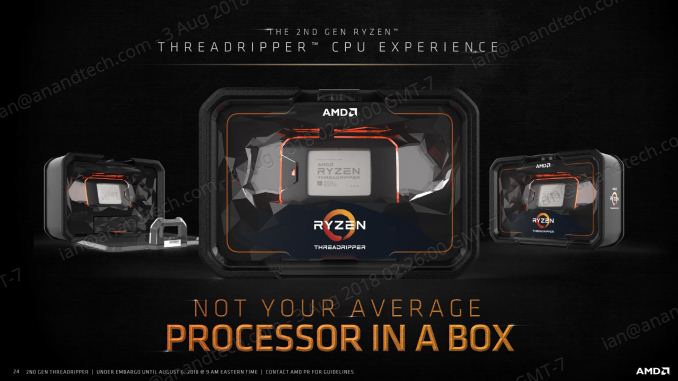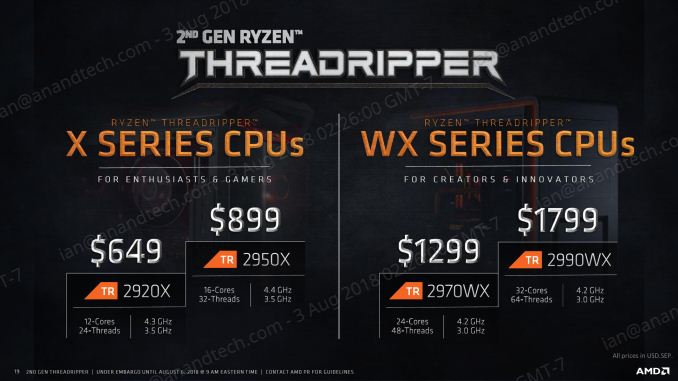The AMD Threadripper 2 Teaser: Pre-Orders Start Today, Up to 32 Cores
by Ian Cutress on August 6, 2018 9:00 AM EST_678x452.jpg)
The biggest news to come out of Computex, AMD’s second generation of its Ryzen Threadripper platform, is almost here. Today’s announcement is all amount images, speeds and feeds, specifications, and an ‘unboxing’ announcement, leading to pre-orders a week before retail. As much as it pains me that there is an unboxing embargo and pre-orders before we even know how the new chips will perform, here we are. Today we get to go through the on-box specifications, discuss the design, and show what AMD included in our press kit.
2990WX Pre-Orders Open Today, Retail August 13th
The formal launch of the new parts is one week from today, and in the biggest markets the first processor of the launch should be available for pre-order. AMD is set to launch four versions of its second generation Ryzen Threadripper over the course of Q3, starting with its flagship 32-core.
| AMD SKUs | |||||||
| Cores/ Threads |
Base/ Turbo |
L3 | DRAM 1DPC |
PCIe | TDP | SRP | |
| TR 2990WX | 32/64 | 3.0/4.2 | 64 MB | 4x2933 | 60 | 250 W | $1799 |
| TR 2970WX | 24/48 | 3.0/4.2 | 64 MB | 4x2933 | 60 | 250 W | $1299 |
| TR 2950X | 16/32 | 3.5/4.4 | 32 MB | 4x2933 | 60 | 180 W | $899 |
| TR 2920X | 12/24 | 3.5/4.3 | 32 MB | 4x2933 | 60 | 180 W | $649 |
| Ryzen 7 2700X | 8/16 | 3.7/4.3 | 16 MB | 2x2933 | 16 | 105 W | $329 |
Sitting at the top of the stack is the 32-core 2990WX, which will retail at $1800, competing directly against Intel’s existing 18-core part, the Core i9-7980XE. AMD is using "WX" in the name here to offer some branding consistency with their high-end workstation graphics models, the Radeon Pro WX series.
Beating at its heart are four 12nm "Zen+" Zeppelin dies, each with eight cores, connected by AMD’s Infinity Fabric, and using simultaneous multi-threading for a total of 64 threads. As with previous generations, there are 60 PCIe 3.0 lanes for add-in cards and storage, and another four lanes for the chipset. There is a slight change in the memory speed, with the new parts supporting DDR4-2933.
Joining the WX line is the Ryzen Threadripper 2970WX, set at $1299 MSRP. This 24-core part uses three cores per CCX (so six cores per die, four dies per package), and also has simultaneous multi-threading for a total of 48 threads. Speeds are equal to the TR 2990WX, with a 3.0 GHz base clock and a 4.2 GHz single core turbo. Per-core turbo speeds will be decided by Precision Boost 2 and XFR2, as explained below. The 2970WX is set for an October launch.
Both of the WX models are hitting the new TDP of 250W, although the way AMD measures TDP is heavily dependent on the cooler used. In this case, their new high-end ‘Wraith Ripper’ cooler is the benchmark, which is developed by Cooler Master. This new cooler is very large, but offers full heatspreader coverage – which as we've discovered is critical for Threadripper cooling – and provides good clearance for memory. It will be sold separately in the channel, at around $100 MSRP.
Also on the table are the 2950X ($899) and the 2920X ($649), which use the existing X branding. This is because these processors are direct replacements for the 1950X and 1920X, using only two active dies in each chip, but this time around are using Zen+, the second generation Ryzen features such as faster caches and better frequency characteristics. The 16-core TR 2950X will have a base frequency of 3.5 GHz, a turbo of 4.4 GHz, and is due to launch on August 31st. The 12-core TR 2920X by comparison also has a 3.5 GHz base frequency, but a slightly lower turbo at 4.3 GHz, and is due out in October. Both of these parts are set at 180W TDP, like the first generation chips.
| AMD Ryzen Product Stacks & Launch Prices | |||
| Ryzen 1000 (2017) | Ryzen 2000 (2018) | ||
| - | TR 2990WX (32C) | $1799 | |
| - | TR 2970WX (24C) | $1299 | |
| TR 1950X (16C) | $999 | TR 2950X (16C) | $899 |
| TR 1920X (12C) | $749 | TR 2920X (12C) | $649 |
| TR 1900X (8C) | $599 | - | |
| Ryzen 7 1800X (8C) | $499 | Ryzen 7 2700X (8C) | $329 |
| Ryzen 7 1700X (8C) | $399 | ||
At this point AMD has not stated if it will expand the family even further, so we don't know if the 1900X will stay at the bottom of the stack, be replaced with a 2000 series model, or if it dies off completely.
At this point, AMD’s main competition is still with Intel’s Skylake-X parts. The 32-core 2990 WX will align in price with the 18-core Core i9-7980XE.
| Threadripper 2 vs Skylake-X The Battle (Sorted by Price) |
||||||||
| Cores/ Threads |
Base/ Turbo |
L3 | DRAM 1DPC |
PCIe | TDP | SRP | ||
| Intel | i9-7980XE | 18/36 | 2.6/4.4 | 24.75 | 4x2666 | 44 | 140W | $1999 |
| AMD | TR 2990WX | 32/64 | 3.0/4.2 | 64 MB | 4x2933 | 60 | 250W | $1799 |
| Intel | i9-7960X | 16/32 | 2.8/4.4 | 22.00 | 4x2666 | 44 | 140W | $1699 |
| Intel | i9-7940X | 14/28 | 3.1/4.4 | 19.25 | 4x2666 | 44 | 140W | $1399 |
| AMD | TR 2970WX | 24/48 | 3.0/4.2 | 64 MB | 4x2933 | 60 | 250W | $1299 |
| Intel | i9-7920X | 12/24 | 2.9/4.4 | 16.50 | 4x2666 | 44 | 140W | $1199 |
| Intel | i9-7900X | 10/20 | 3.3/4.3 | 13.75 | 4x2666 | 44 | 140W | $980 |
| AMD | TR 2950X | 16/32 | 3.5/4.4 | 32 MB | 4x2933 | 60 | 180W | $899 |
| AMD | TR 2920X | 12/24 | 3.5/4.3 | 32 MB | 4x2933 | 60 | 180W | $649 |
| Intel | i7-7820X | 8/16 | 3.6/4.3 | 11 MB | 4x2666 | 28 | 140W | $593 |
| AMD | TR 1900X | 8/16 | 3.8/4.0 | 16 MB | 4x2666 | 60 | 180W | $549 |
| AMD | R7 2700X | 8/16 | 3.7/4.3 | 16 MB | 2x2933 | 16 | 105W | $329 |
Across the metrics, AMD has more cores, is competitive on frequency, has more memory channels, more PCIe lanes, and supports higher memory clockspeeds. Intel has lower power, and above 16 cores a slight turbo clockspeed advantage. Meanwhile we already know from Ryzen 2000-series testing that cache speeds are a back-and-forth competition, and Intel has a slight IPC advantage. Game on.












101 Comments
View All Comments
mjz_5 - Monday, August 6, 2018 - link
Wow, come on people. We should all be praising AMD and hating INTEL for juicing us up for all these years. We should welcome competition and purchase AMD to show Intel that what they have done in the past is not right!mapesdhs - Monday, August 6, 2018 - link
Buy AMD if it's a better solution for your problem, not because doing so somehow conveys some emotional concept of which Intel will be completely unaware. Buying things in that way is no less daft than buying Intel just because it's Intel. Steve at GN describes this whole thing best, in this case with regard to GPU flame wars, but the same thing applies to CPU arguments:https://www.youtube.com/watch?v=ZyAOtQOu2YM
And what does "hating Intel" even mean? Intel is a company; as such, it isn't an entity with agency and awareness with which it can respond to someone who 'hates' it. So much emotional language with all this. :D Fact is, nobody has been forced to buy an Intel CPU for their gaming PC or whatever, they made a free choice to do that.
This is more to do with the expression of in-group preference, people feeling like they're with one gang or the other, or the need to defend their purchasing decisions.
If you don't like some product strategy that Intel uses, then don't buy their products, or if you still need something better and AMD has nothing to offer, then look at the 2nd-hand market, eg. there's often good value in used XEONs, and even today, old X79 can often hold its own rather well (especially for gaming above 1080p).
Ian.
Fujikoma - Monday, August 6, 2018 - link
In the U.S., the courts have determined that a business can have beliefs with which to avoid laws and discriminate. Hobby Lobby decision. Citizens United decision. Not disagreeing with what you're saying, but the U.S. has some issues when classifying people and for-profit entities.Oxford Guy - Tuesday, August 7, 2018 - link
Certain people have been determined, as usual, to have fewer rights than others. Protected classes can't be discriminated against.PeachNCream - Monday, August 6, 2018 - link
The new Threadrippers are interesting products, but I'm not really that concerned either way about how they actually perform since they're not practical products for any of my computing needs. They're too hot to cool passively, too big for a laptop chassis, and far too expensive for web browsing or watching a few videos. It's a shame Anandtech doesn't review much mid- to low-end hardware anymore since things like a 32-core x86 CPU are interesting, such processors are going to end up in a very tiny portion of even Anandtech's readers' enthusiast class PCs.Sttm - Monday, August 6, 2018 - link
What do you feel is not getting covered? I remember them covering mainstream Ryzen 2, and APU low end Ryzen 2, and the new Core 8086 and a lot of other consumer focused cpus before that.So more laptop stuff?
PeachNCream - Monday, August 6, 2018 - link
Right off the cuff, without thinking much about it, the 1050 and 1030 weren't reviewed. There were a couple of lower end AMD GPUs that were omitted as well. There are few to no networking benchmarks and the first complete desktop review done in a long time was for a relatively high end system. It's sort of sad to go to Anandtech to read a review about upper tier stuff I'll never purchase, but then have to go spelunking with a search engine to find multiple lesser quality reviews for things I'll actually purchase and yes that certainly includes laptops and more I'll toss in reasonably priced phones there too.Cooe - Monday, August 6, 2018 - link
Complete desktop reviews & similar are not AnandTech's target market, never have have been so I wouldn't hold out too much hope for that to change. It's always been a site about ala-carte PC building hardware 1st & foremost; dunno why you'd expect anything different all the sudden tbh.PeachNCream - Tuesday, August 7, 2018 - link
At the top of Anandtech's website, check the bar under the site logo for the word "SYSTEMS" and hover your mouse over it to view the subcategories and browse a few links within. Also check the "SMARTPHONES & TABLETS" category.Sttm - Monday, August 6, 2018 - link
This is so cool. Though I don't think I'd recommend any non business owners from buying it. As with 7nm Zen 2 based TR coming next year, I cannot imagine your $1800 expenditure won't feel incredibly foolish in 12 months. If they can fit 32 at 12nm, how many can they are 7nm, and superior cores as well!